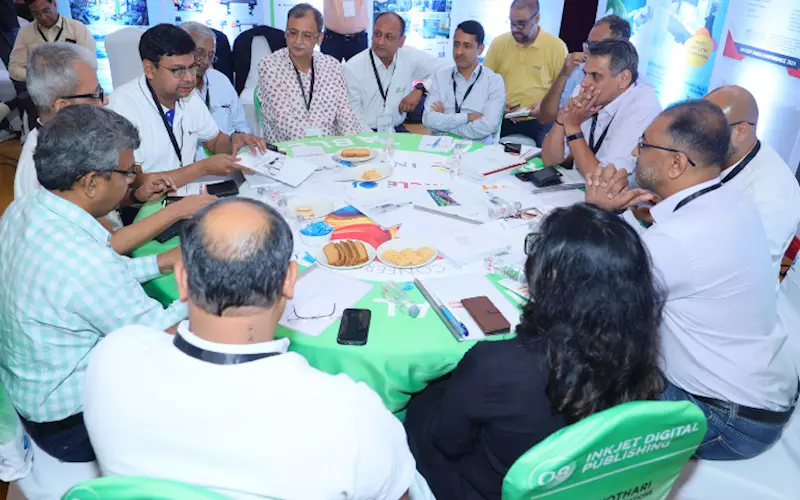Small investors to power inkjet press installation in 2024; all eyes on Drupa
As India is poised to install many more inkjet presses, the participants at the inkjet digital publishing roundtable participated with lots of interest. Most of the responses which were fielded by Ajay Agarwal, CEO and MD of Insight Print Communications addressed the firepower of single-pass inkjet presses and Capex versus Opex.
08 Apr 2024 | By Ramu Ramanathan
Ajay Agarwal shared with the delegates that a total of eight inkjet Atexco web presses will be installed in Delhi, Pune, Nagpur, etc. He said, the press is targeting textbooks, and the education market in India. Later through a show and tell with samples of books and print outputs, he showcased the high-quality output. He said, "There is a huge benefit of using water-based inkjet technology whilst achieving the highest print quality."
The roundtable had heavyweights from the book publishing fraternity. It included, Repro (book printer); Sheth Publishers (publisher-printer with 1,800 book titles on the roster); Kapur Press (Jaipur based major who specialise in government orders); Shivam (Kolhapur-based major with a battery of 17 web offset); etc.
The 90-minute freewheeling discussion focussed on the CapEx (which will depend on the configuration. Also what is a good service model for an inkjet press as well as standard warranty and AMC after warranty expires. Also what type of RIP/controllers is good for an inkjet press engine. Later Kedar Ambekar of Nikeda Art Printers who is also the chairman of the roundtable discussed the pros and cons of water-based inks as well as paper-based substrates and coated / uncoated paper.
Rahul Kapur of Kapur Press wanted to know if normal creamwove paper 60 gsm of a B grade Indian paper mill be used on the machine. Agarwal said, two important properties for the paper is, it should have a good tensile strength and should have low fluff. Agarwal, highlighted the point that High fluff paper is clearly avoidable.
There were many queries about bindery; especially collating, pinning, cutting and stacking for making booklets. Deepak Sheth of Sheth Publishers wanted to know if the bindery can achieve speeds of 150 m per sec. To which Agarwal said, "150 metres per minute is the maximum speed. And for some jobs it is practical to run the device 65% lower. This, he said, translated into 50,000 to 80,000 A4 impressions per hour.
The trends that emerged from the discussion was the emergence of a new category of book print firms "the middle-class book print firm". This means, a firm that converts 5,000 books per day, in a 2,000-sq ft space. Aggarwal said, "At the end of the day, all the books are dispatched". This, he said, is “book magic”.
The other trend is as more and more book print firms will shift to inkjet for their short run book jobs, since it has lower running costs. This means, inkjet will be seen as a perfect solution between toner print and offset printing. Aggarwal said, "Digital book printing with high speeds competes with offset and depends on two raw materials, ink and paper. And this is happening in India.”
Ajay Aggarwal, shared an interesting insight about the Surat market for inkjet devices. This, he said, is because of the presence of printers who print one-sided inserts and leaflets. “For them, we have introduced a machine with a single engine solution. Hence, when these customers use toners to print an A4 sheet, the cost is brought down to one-third of the original cost; saving them two-third of the price,” he explained.
Later the discussion shifted offline and the roundtable participants were keen to know about the other devices other than the Atexco web press.
In this context, the following presses were discussed.
At the last Drupa in 2016 Canon showed a prototype B2-plus sheetfed inkjet press, the Voyager. It used an offset cylinder to transfer up to seven colours onto standard uncoated or gloss coated papers at speeds of up to 3,000sph. Presently, Canon is tight-lipped on its plans for a B2 inkjet but there’s a hint something could be in the works and the promise of more details at the show.
Meanwhile Drupa will be the global launch for the Jet Press 1160CFG continuous feed inkjet, featuring Fujifilm paper stabilisation tech that would “overcome most difficulties” of high-speed inkjet printing.
HP has announced two new capabilities that further expand the versatility of its HP PageWide Advantage 2200 web inkjet press: Heavier Media Expansion, which enables printers to use thicker substrates, for jobs up to 320gsm; and Magnetic Ink Character Recognition (MICR) for Transactional Print Systems, which the company said enables printers to capture more speciality jobs and grow their business.
Also, Kodak will up its game with the Prosper Ultra 520 high-speed inkjet press. readers of PrintWeek will recall that the first Ultra 520 was installed last year as part of a controlled introduction of the press, which uses Kodak’s Ultrastream continuous inkjet technology. Kodak said the Ultra 520 would be shown running with “newly launched versatile Kodak manufactured pre and post finishing solutions”, although further details are under wraps until the show.
Konica Minolta, which has alliances with Landa, for the Impremia NS40 B1 digital press using Landa’s Nanography inkjet technique, will showcase the IS29S B2 format UV inkjet.
And finally, there is the OrientJet from The Printers House which is a true-blue Make in India press. The Faridabad-based manufacturer is using their in-house RIP/controller developed with Arden. At Pamex, the company spokesman pointed out the finishing options for publishing which included sheeting , folding, and binding. TPH offers a 13 inch model, a 17.5 inch model, a 20 inch model as standard but sizes can be customised up to 36 inches.











 See All
See All